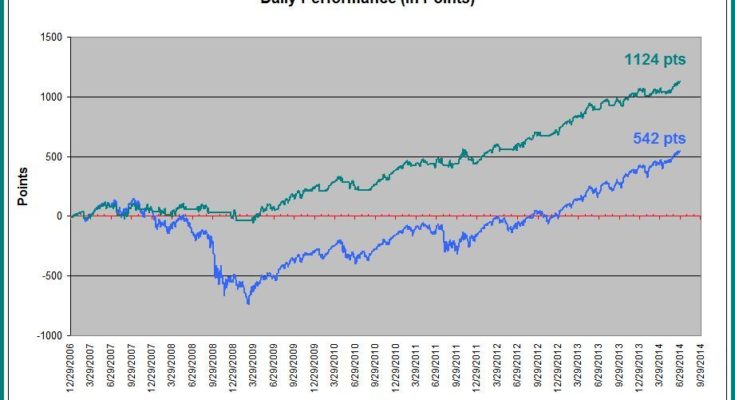The Performance page of our website lists Asbury Research’s market calls for various areas of the US financial landscape — including our trend model for the US stock market.
Our trend model was designed to be a simple and objective tool that quantitatively determines when the near term (monthly) trend is positive or bullish, and when it is not.
Investors evaluate models by performance. Here is ours, beginning in 2007 and through Q2 2014, versus the S&P 500.
 This information is provided for information purposes only. Past performance or back-tested results may not necessarily indicate future results. The results indicated from back-testing or historical track record may not be typical of future performance. No inferences may be made and no guarantees of profitability are being stated by Asbury Research LLC. The risk of loss trading in stocks, futures, commodities and Forex can be substantial. You should therefore carefully consider whether such trading is suitable for you in light of your financial condition.
This information is provided for information purposes only. Past performance or back-tested results may not necessarily indicate future results. The results indicated from back-testing or historical track record may not be typical of future performance. No inferences may be made and no guarantees of profitability are being stated by Asbury Research LLC. The risk of loss trading in stocks, futures, commodities and Forex can be substantial. You should therefore carefully consider whether such trading is suitable for you in light of your financial condition.
Our trend model is not intended to be a stand-alone, one size fits all trading system, but rather just one of many different metrics that we employ to produce a comprehensive market analysis, one that we believe is collectively more insightful and forward-looking than any of its individual components.
Our model doesn’t use short positions, or leveraged longs, or futures or options strategies — just a very simple and binary “in or out†mechanism using the bellwether S&P 500 as a proxy.
Our model argues against the buy and hold “strategyâ€, and the assertions by its proponents that “you can’t time the market†and “you can’t beat the marketâ€.
Although buy and hold advocates can correctly point out that the S&P 500 is up 6.1% for the 1st Half of 2014 compared to just 2.9% for our trend model, we would counter by saying that attempting to get out of the way of an emerging market decline comes with the inherent risk of potentially missing out on some performance — especially within a Fed stimulus-fueled environment that has been a big part of atypically pushing the S&P 500 higher for the past 6 quarters without a meaningful correction.  Poor hedge fund returns since 2013 are a testament to this.

